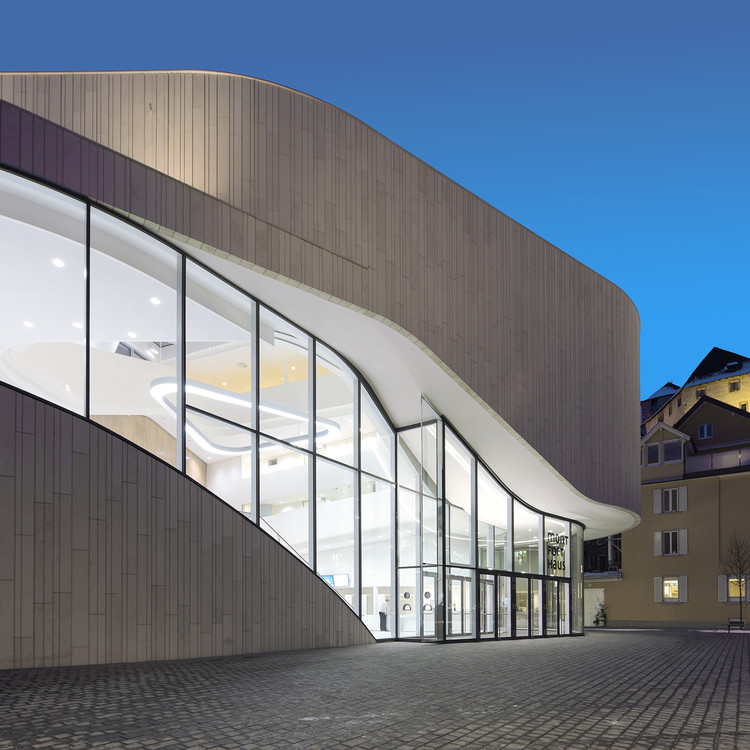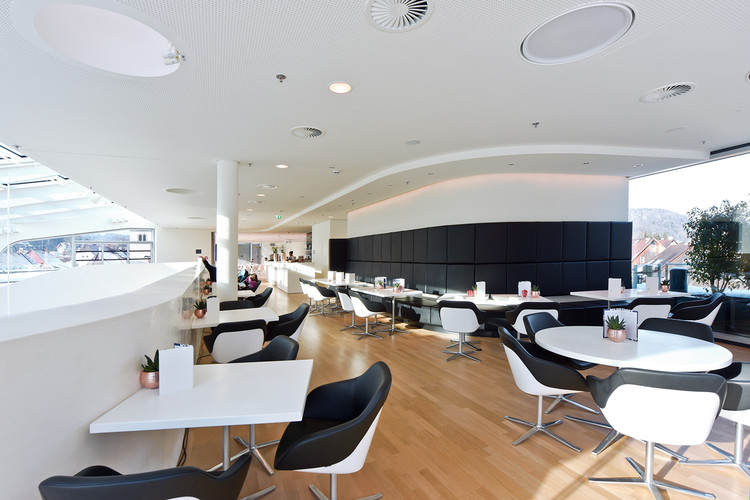
-
Architects: Hascher Jehle Architektur, mitiska wäger architekten
- Year: 2015
-
Photographs:Svenja Bockhop, Benjamin Marte
-
Manufacturers: Franken-Schotter, GIRA, dormakaba, Arper, FSB Franz Schneider Brakel, Fabromont AG, GEZE, Glas Marte, Hiller Furniture, Kone, Lauster Steinbau, Rosconi AG, SFL technologies GmbH, Schüco, Softline, Villeroy & Boch, Vitra, Walter Knoll, Zumtobel, din Sicherheitstechnik


Text description provided by the architects. The new Montforthaus is a multi-purpose cultural centre for the people of Feldkirch and the surrounding region. It is versatile enough to host conventions, balls, trade fairs, classical concerts, pop concerts and theatre performances. The Montforthaus is harmoniously embedded in the historical urban grain of the medieval old town of Feldkirch. While its formal articulation is demonstratively modern, its materiality picks up the traditional Jura marble of the region, setting up a dialectical frisson between the two while simultaneously weaving the new insertion into the existing fabric of the town.

Like a pebble in the riverbed of the town, the new cultural centre sits in the flow of urban space between three adjoining squares which fuse into a single large urban space. The same natural flow of space continues into the building, leading visitors into a four-storey landscape of foyers and open galleries beneath a naturally illuminated glazed atrium roof. With its transparent front the Montforthaus is inviting passers-by into the Montforthaus. It leads directly into the almost 15 metre high, brightly lit open foyer. The seamless flow of space from outside to inside and the fully glazed walls of the foyer make the surroundings part of the space and contribute to the sense of an expansive interior. A broad sculptural stair leads visitors up from the entrance to the gallery levels, the small auditorium, seminar rooms and from there on to the roof terrace.

The spatial continuum that extends the entire height of the building with its galleries and myriad visual connections is especially suitable for large events. Multi-purpose spaces can be opened up or closed off as needed to suit a wide range of different needs and constellations. The new public building provides a total of 12,700 m² of gross floor area. The core functional elements of the building are distributed directly around the foyer and can be joined or separated as required. The extensive foyer zone forms a spacious entrée to the large concert hall. The large and small concert halls as well as the multi-purpose spaces are articulated as a single large organic volume, the form of which can be seen from outside.

The aim of creating an acoustic environment in the Montforthaus that offers both the musicians playing in the orchestra and the audience an aural experience comparable to that of a philharmonic hall was a significant challenge. More than 300 m² of the internal surfaces have been made adjustable, for example 6 movable acoustic sails in the ceiling. Of the various elements, some are motorised and some mechanically operated – depending on the use of the hall – so that specific acoustic configurations can be activated or deactivated. As such, the reverberation time can be optimised to meet specific requirements. As with the acoustics, the planners had to find a balance between the very different staging demands of concerts, conventions, balls, etc. Each of these different kinds of events involves aspects that have different and sometimes conflicting technical requirements. As a consequence, certain building elements were designed to be multi-functional from the outset.

The wish to be able to achieve rapid scene changes seemed at first glance impossible given the building height limitations of the urban plan – a typical fly tower needs to be three times the height of the stage opening. The fly tower in the Montforthaus is divided into segments with a fly system, segments with equipment catwalks, and segments without. An arrangement of this kind has not been used before in this configuration and is therefore an innovation specially developed for the building. Aside from the custom solutions for staging technology, a further special development is the lighting of the halls and foyer. The lighting design office LDE Belzner Holmes, which specialises in architectural and stage lighting, designed a lighting scheme that complements the underlying architectonic idea of the building. The artificial lighting of the interior augments the incident daylight from the generous roof glazing to create a sense of uniform natural illumination throughout the entire foyer. The centrepiece of the foyer is a modern interpretation of a chandelier, with a form that echoes and illuminates the organic triangular shape of the glazed roof of the foyer. Like the other lights in the public areas of the building, the light temperature of the chandelier can also be adapted to suit the respective occasion.

The vertical patterning of the natural stone façade made of light Jura limestone underlines the sculptural form of the building without requiring curved sections and lends the building a sense of elegant restraint. The Jura limestone façade, comprised of 30 cm wide, 4 cm thick and at times over 200 cm long hung stone panels, has a total surface area of 2150m². The vertical panel edges are precisely milled to allow them to overlap, obviating the need for open panel seams. The Montforthaus has been planned in accordance with “Green and Smart Building” concepts. During all stages of the design process, opportunities to exploit synergy effects between the architecture, technical services and building physics were investigated. The integral life cycle concept reduces both the investment as well as the running costs. Coatings, paints and insulation materials, as well as the façade materials, were selected and used according to environmental criteria. Parking spaces for electric bicycles and charging stations for electric vehicles complement the sustainability credentials of the building.

The Montforthaus conforms to Energy Efficiency Class A. Even the restaurant on the upper storey uses predominantly local produce. The operator has likewise embraced the building’s sustainable concept and has been awarded Austrian Environmental certification as a “venue for green meetings and green events”.


























